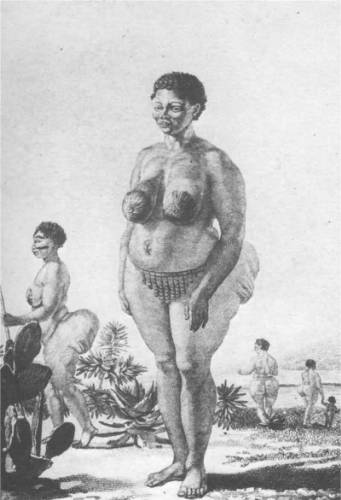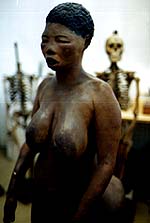Saartjie Baartman was a Southafrican San or Hottentot. She was displayed at London and Paris freakshows, from 1810 to 1815. Five years after her arrival, she died. The famous anthropologist, director of the Musée de l’Homme Georges Cuvier was very quick to claim her corpse. He took great care putting her brains, genitals and buttocks in jars with formalin, but he did not care to find out what caused her death. This way, he finally got a hold on her genitals, which she refused to show during her lifetime.
The movie
‘Horrible! So horrible’ were Kurtz’ last words in Joseph Conrad’s Heart of Darkness. Those words flow through me while I watch Abdellatif Kechiches movie ‘La Vénus Noire’.
It is a horribly long, sickening portrait of abuse, humiliation, maltreatment of an exhibited woman, based on the true story of Saartjie Baartman. No possibility to escape in this movie, not a grain of hope, we must undergo the horror until the bitter end. In close-up.
My first reaction is to doubt the historical adequacy of the movie; was Saartjie Baartman really addicted to alcohol? Did she end up in the Paris prostitution ? Did she have a venereal disease?
I want to blame the director Abdellatif Kechiche that there is no historical research-team in the end-titles. That he made things up to express his disgust. That he feels himself a victim of the West, or rather the North.
Then I realize that I am angry and hurt because the movie is too hard to digest.
But: what should Kechiche have made then? A happy end movie? Giving hope?
The fact is that Saartjie Baartman, young and healthy, left South-Africa for Europa and five years later she was dead. So ‘we’ did not take good care of her. She was forced to perform a humiliating show, she was measured in detail by scientists but refused to show her genitals. The sum of what we actually know is in fact enough to implement the rest with other horrible details.
The movie pushes us, like a puppie, with the nose in the own excrements. ‘Us’ in this case being the western public. Or: the movie adequately plays the always ready guilt feelings of the western intellectual?
It does so by filming in close-up the gaze of the Western public (of 1805) : awe, astonishment, curiosity, amusement, disgust, horror, fear, lust. Towards the object ‘Black Venus’. And indifference towards the person of Saartjie.
Even the people of the Londoner ‘Africanist society’, taking her owner to court and ‘defending’ Saartjie Baartman, are not so much interested in her as in defending their own morality.
Kechiche seems angry. In the linked interview in Cinémotions he tells how, being an arab actor in France, he had to play parts that confirm the predjudices, the reducing gaze. It is this gaze he wanted to analyze in the movie.
Aline with whom I saw the movie, asks me: how do you see this movie in relation to your project?
O gott! I want to show a totally different image, indeed with indignation, but also positive stuff. I have to think about it.
The facts?
Saartjie Baartman was a young San (or Hottentot) who lost her family in a killing by South-African ‘boers’. She served as a nanny in a family and was taken to Europe by her owners brother, Hendrick Cezar in order to be shown at the public for money. The show Hendrik put together for the Freakshows was humiliating; she had to perform as a wild animal. This we know thanks to articles and a lawsuit started by the Africanist Society in London. Later she was moved to Paris where Cuvier’s team measured her. She spoke South-African, some English and some French. She was sold to a different ‘impresario’, and some time later she was dead. That is about all that is known about her.
Book : L’énigme de la Vénus Hottentote
Annoying book because, where it misses facts, it fills the pages with lengthy guessing like ‘And what if in this situation Saartjie would have been feeling this or that?’ ‘Maybe this and that may have happened and then she might have reacted like this and that’.
And in fact, not so many facts are known. So while reading the book, you have to try and filter out the proven facts. That might be a nice game for a fiction book, but not a historical one!
Anyway this is the book everyone refers to when speaking of Saartjie Baartman.
Documentary movie : On l’appelait la Vénus Hottentote by Zola Maseko, SA, 1998, 52’
A reconstruction of the life of Saartjie Baartman, using archive materials like photo’s, drawings, text and analyses by five different specialists. Interesting movie. I am also very happy that I could take it home thanks to the friendly personnel of the médiathèque du Quay Branly in Paris. They have it only on video and have no lecteur in their library.
Like ‘El Negro’, the remains of Saartjie Baartman were brought back to Africa for a new burial.
At the end of the documentary, we discover that the genitals and brains of Saartjie Baartman, in their jars with formalin, got lost. They are no longer at the Musée de l’Homme. Would they be at L’institut du jardin des plantes? In any case, the movie concludes that it is bad for everyones spirit, that remains are left somewhere…





